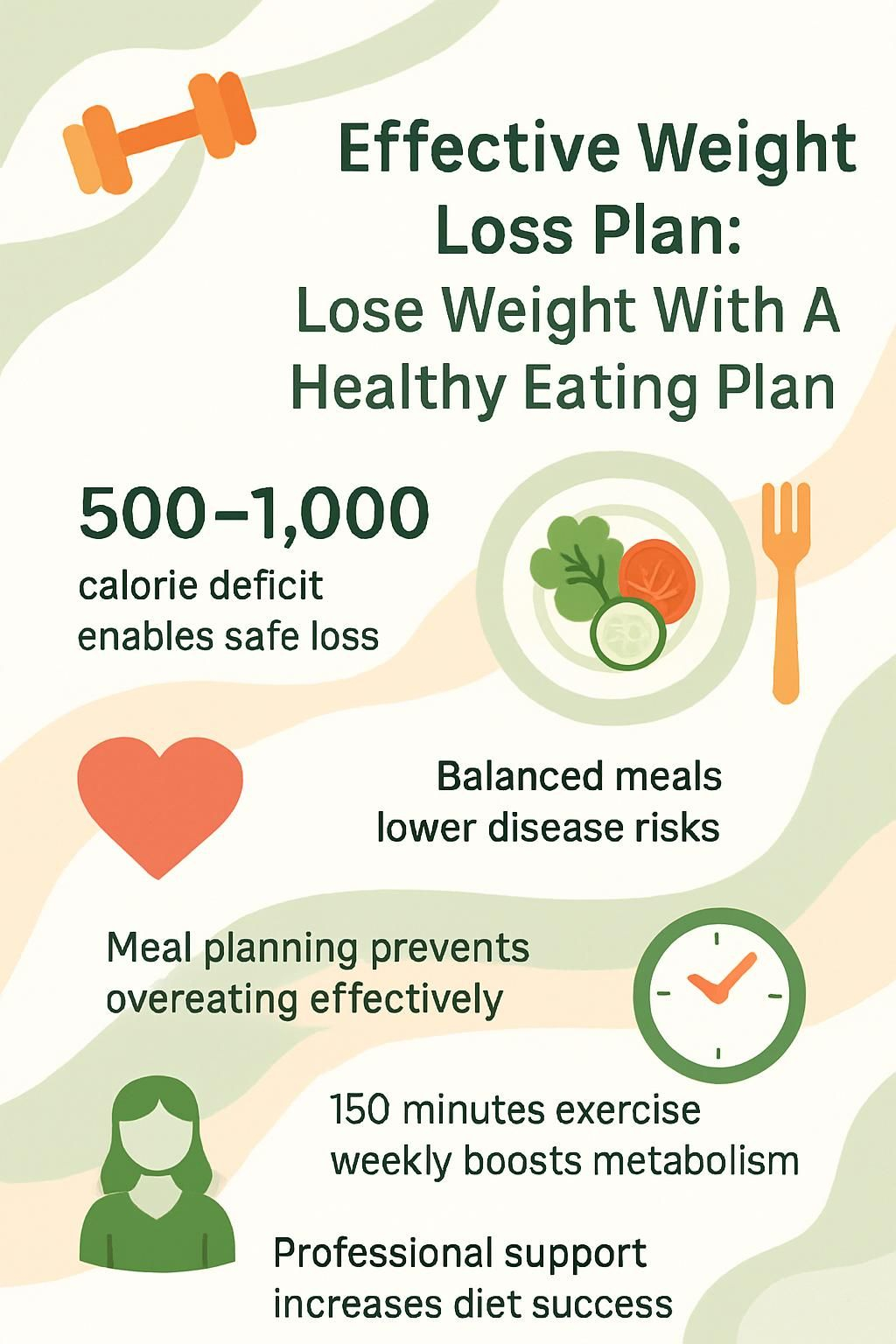Effective Weight Loss Plan: Lose Weight With A Healthy Eating Plan
Our Nutrition Assistant AI Suite will transform your body. You will lose fat, get toned, and build muscle. Gain confidence and optimal health.
You may feel stuck after trying to lose weight and then gaining it back. A realistic weight loss plan built on healthy eating and regular physical activity can help you make steady progress. You can lose weight and keep it off with small changes that you repeat each day.
In this guide, you will learn simple steps to build an eating plan, choose nutrient dense foods, set goals you can reach, and create habits that last. If you want clear answers on how to lose weight safely, you are in the right place.
Key Takeaways
- A calorie deficit of 500 to 1,000 calories per day supports safe weight loss of 1 to 2 pounds per week, as noted by the Mayo Clinic and CDC.
- Balanced meals with fruits, vegetables, lean proteins, and whole grains lower the risk of heart disease and type 2 diabetes while supporting long-term weight management.
- Meal planning and portion tools such as the Healthy Weight Pyramid help prevent overeating and keep results steady without strict calorie counting.
- Regular physical activity, at least 150 minutes each week, and 7 to 9 hours of sleep improve metabolism and reduce weight regain after dieting.
- Professional support from a healthcare provider improves safety and success, especially with low-calorie diets or chronic conditions.

Essentials of Weight Loss

A healthy eating plan helps you lose weight and keep it off. Calorie control sits at the center of safe weight loss and better health.
Why is a healthy eating strategy important for weight loss?
Healthy eating forms the base of a successful weight loss program. Choosing foods that are low in calories and high in fiber, such as vegetables, fruits, whole grains, beans, fish, nuts, and healthy fats, helps you feel full longer. This supports your metabolism, the process your body uses to convert food into energy.
The Mayo Clinic Diet promotes these habits to support long-term weight management and lower the risk of heart disease and type 2 diabetes. Thoughtful food choices can also help reduce blood pressure and the risk of sleep apnea or prediabetes.
Many readers report feeling satisfied after swapping processed snacks for meals with lean protein and colorful produce. You can see steady results without feeling deprived.
A healthier lifestyle starts with small changes. Each smart meal choice builds momentum.
How does a calorie deficit help you lose weight?
A calorie deficit means eating fewer calories than your body uses each day. Your body then taps stored fat for energy, which leads to gradual fat loss. Tracking apps and food diaries make this easier to manage.
Very low-calorie diets, or VLCDs, limit intake to about 800 calories a day. They can trigger rapid weight loss, often 3 to 5 pounds per week, but they require medical supervision. Most adults do better with a low-calorie diet, usually 1,200 to 1,500 calories for women and 1,500 to 1,800 for men. Slow and steady reduction is safer and easier to maintain than relying only on more exercise.
Focusing on consistent calorie reduction helps you see real changes on the scale and improves your odds of keeping a healthy weight long term.
Crafting Achievable Objectives
Clear goals help you keep a healthy weight. Realistic targets encourage habits that last.
What is a realistic rate for gradual weight loss?
Aim to lose 1 to 2 pounds per week while you follow a healthy diet and maintain a calorie deficit. The Mayo Clinic Diet and many experts support this rate for safety and long-term success. Some people progress at 0.5 to 1 pound per week, which is also fine.
Fast dieting can be tempting. Still, a slower pace often leads to better maintenance. Small weekly goals keep you moving forward and reduce the urge to quit.
A steady pace wins the race in your weight loss journey.
Why should extreme dietary restrictions be avoided?
Severe restrictions can cause more harm than good. Rapid weight loss often comes from water, muscle, and even bone density, not just fat. Side effects may include fatigue, constipation, diarrhea, gallstones, nausea, or gout.
VLCDs are not safe for most people unless supervised and should not last beyond 12 weeks. Crash diets can slow your metabolism and lead to weight regain, also called weight cycling. Research links harsh plans with higher risks of high blood pressure and kidney issues. Sustainable changes in diet and activity are safer and work better.
Key Elements of a Successful Weight Loss Strategy
Successful weight loss brings healthy foods and regular exercise together. Focus on habits you can repeat even on busy days.
How can balanced nutrition support weight loss?
Balanced nutrition gives your body what it needs while controlling calories. The Mayo Clinic Diet encourages vegetables, fruits, whole grains, nuts, beans, fish, and healthy fats. High produce intake offers vitamins and dietary fiber that keep you full on fewer calories. Whole grains help steady blood sugar and curb cravings.
Lean proteins protect your muscles during weight loss. Some plans allow a small dessert, for example up to 75 calories per day, which can make the plan easier to follow. This flexible approach works with many eating styles, including Mediterranean and vegetarian patterns.
What types of exercise should be included regularly?
Combine aerobic exercise with resistance training. Brisk walking is a simple way to start if you need to lose weight. Aim for at least 30 minutes most days. This supports heart health and lowers the risk of stroke, some cancers, and diabetes.
Strength work using bands, weights, or body weight builds muscle. More muscle raises your resting metabolism, so you burn more calories all day. Work toward 150 minutes of moderate activity per week, such as cycling or swimming. If you are new to exercise, begin with 5 to 10 minute sessions and build up gradually. Taking the stairs or parking farther away adds helpful movement without a formal workout.
Why is staying hydrated important for weight loss?
Water supports your metabolism and helps you burn more calories while at rest. A glass of water before meals can curb hunger and improve portion control.
Replacing sugary drinks with water cuts calories and improves focus. Adequate fluids also reduce headaches and fatigue, which can limit workouts. Hydration makes it easier to keep your eating plan on track.
How does adequate sleep affect weight loss efforts?
Sleep supports appetite control. Most adults need 7 to 9 hours nightly. Too little sleep raises ghrelin, a hormone that increases hunger. It also lowers leptin, a hormone that signals fullness. This combination can lead to overeating.
Short sleep can raise cortisol, a stress hormone, which may increase cravings for high calorie foods. Studies link poor sleep to weight regain after dieting. Good sleep helps you stick to healthy habits, including meal planning and exercise.
Fundamentals of a Healthy Eating Regimen
A healthy eating regimen lowers the risk of many health conditions and supports weight goals. You can lose weight and feel better with a few consistent steps.
Why focus on whole, unprocessed foods?
Whole foods offer more nutrients per calorie and help you stay full. The Mayo Clinic Healthy Weight Pyramid highlights fruits and vegetables because they contain fiber and natural sugar in fruit without extra additives.
People who lose weight often eat more whole grains, lean proteins, and fresh produce instead of ultra-processed snacks. Choosing real food helps reduce the risk of heart disease and diabetes. It also makes tracking easier because the ingredients are simple. Meal prep often takes less time when your shopping list is short and clear.
How do lean proteins, whole grains, fruits, and vegetables aid weight loss?
Lean proteins keep you satisfied and support muscle. Options include grilled chicken, fish, eggs, tofu, and beans. Whole grains like brown rice, oatmeal, and quinoa provide steady energy and fiber.
Fruits and vegetables fill your plate with few calories and plenty of vitamins. Fiber helps control appetite. Diets rich in produce tend to support greater weight loss than low produce diets. You can build meals that feel generous and still fit your plan.
How can you reduce added sugars and unhealthy fats?
Start with label reading. Many items such as flavored yogurt, canned soups, and dressings contain hidden sugar or unhealthy fat. Choose water, unsweetened tea, or black coffee instead of soda or fruit punch. Trade frying in butter for baking, grilling, or steaming with olive oil.
Snack on whole fruit or low-fat yogurt instead of chips or pastries. Cutting added sugar lowers the risk of type 2 diabetes and heart problems. If you need help, ask your healthcare team for a referral to a registered dietitian. Smart swaps reduce calories without extreme rules.
What are effective ways to manage portion sizes?
Portion control supports lasting weight loss. Use the plate method as a quick guide. Fill half your plate with vegetables, one quarter with lean protein, and one quarter with whole grains. Smaller plates can help you serve less without feeling restricted.
Plan meals in advance and pack pre-portioned lunches. Keep nutrient dense snacks on hand to prevent overeating later. Checking serving sizes regularly keeps your diet and exercise efforts aligned with your goals.
Examining Popular Diet Approaches
Many plans can help you lose weight. The best one is the plan you can follow consistently.
What are low-calorie diets and how do they work?
Low-calorie diets reduce daily intake to create a calorie deficit. A typical low-calorie diet provides about 1,200 to 1,500 calories for women and 1,500 to 1,800 for men. Some people use meal replacements along with regular foods to simplify planning.
A very low-calorie diet limits intake to about 800 calories per day. It can lead to faster weight loss, but it should be used only with medical supervision and usually not longer than twelve weeks. Many people prefer a monitored low-calorie approach for steady results and better comfort.
How does intermittent fasting support weight loss?
Intermittent fasting changes eating times instead of specific foods. The 16:8 method limits eating to an eight hour window each day. With less time to eat, many people naturally consume fewer calories. The 5:2 method uses two lower calorie days each week, about 500 to 600 calories, and five usual days.
Short term research suggests both styles can support weight loss. Long term success depends on choosing balanced foods during eating windows and a schedule you can keep. Water and herbal tea can help manage hunger during fasting periods.
[1] Example citation: Varady KA et al., “Short-Term Modified Alternate-Day Fasting,” Obesity Research Journal, 2020
What are the benefits of the Mediterranean diet?
The Mediterranean diet features whole grains, fruits, vegetables, fish or poultry, beans, nuts, and olive oil. Studies link it with lower risks of heart disease and diabetes compared with a Western diet. Many people feel satisfied because meals are rich in fiber and flavor without excess calories.
Mayo Clinic sample menus include options like overnight oats with berries or sheet pan chicken with vegetables. This pattern supports steady energy, good digestion, and stable blood sugar.
Why choose a high-protein diet for weight loss?
Higher protein intake can reduce hunger and protect muscle during weight loss. Protein rich foods, such as lean meats, fish, and beans, keep you full longer than refined carbohydrates. In one study, raising protein to about 30 percent of total calories led participants to eat roughly 450 fewer calories per day.
More protein helps the pounds you lose come mostly from fat. Planning protein at each meal can make your eating plan more satisfying.
Strategies for Meal Timing and Preparation
Meal timing and simple prep routines help you manage hunger and follow your eating plan, even on hectic days.
How does meal timing influence metabolism?
Eating on a schedule helps your body regulate appetite hormones and blood sugar. Time restricted eating, such as 16:8, may improve fat burning and reduce late night snacking. Some studies report greater weight loss with a consistent eating window compared with free timing.
Alternate-day fasting may also improve insulin sensitivity, which helps your body use blood sugar more effectively. Pick a timing approach that fits your life so you can repeat it week after week.
What are tips for planning meals and snacks effectively?
Build your menu around whole foods. Prepare grab and go snacks such as sliced bell peppers, a banana, or a single serving of nuts. Use digital tools or apps to organize a weekly plan and track nutrients.
Choose simple recipes with lean proteins, whole grains, fruits, and vegetables. Shop with a list to avoid impulse buys. With practice, planning becomes routine and supports steady energy through the day.
Impact of Physical Activity in Losing Weight
Movement boosts your metabolism and burns calories. It also improves mood and energy, which makes healthy choices easier.
What are the benefits of consistent exercise?
Regular activity helps manage weight and lowers the risk of chronic disease, including heart disease and type 2 diabetes. People who stay active are less likely to regain lost weight. Exercise also eases stress and improves sleep, two factors that influence appetite and cravings.
Short walks, group classes, or at home routines can all work. Pick activities you enjoy so they become a normal part of your week.
Which types of exercise are best for weight loss?
Walking and resistance training are a strong combo. A 30 minute brisk walk can burn about 150 calories, depending on your pace and weight. It requires no special gear, just comfortable shoes.
Strength training builds muscle, which raises your resting metabolism. Pair cardio, like cycling or swimming, with two or more weekly strength sessions for best results. Many people see steady progress using daily walks plus two short strength days.
Tracking Weight Loss Progress
Keeping simple records makes it easier to spot patterns. You can adjust sooner instead of waiting for a long stall.
How can you monitor your diet and activity levels?
Use a food diary or app to log meals, portion sizes, workouts, minutes active, sleep hours, and stress levels. Tracking builds awareness and accountability.
Apps such as MyFitnessPal allow barcode scanning and quick searches for common foods. Consistent self monitoring is linked with better weight loss, since it helps you make timely changes.
When and how should you adjust your weight loss plan?
If progress slows for several weeks, review your data. You can gently lower daily calories, add fiber and protein, or introduce strength training. Changing one thing at a time makes it easier to see what helps.
Set new goals only after meeting current ones for a few weeks. If you feel dizzy, unusually tired, or stuck for two months, check in with a healthcare provider. A short consult can reveal hidden issues, such as large portions or extra sugars in snacks.
Addressing Common Challenges
Every plan bumps into obstacles. Practical tools can help you recover quickly and stay motivated.
How can you manage setbacks and stay motivated?
Setbacks happen. Write down your reasons for losing weight and post them where you will see them. Reward milestones with non food treats, such as new workout gear or a movie night.
Small, steady changes work best. Losing 1 to 2 pounds per week is safer than fast drops. Focus on habits you kept this week, even if the scale did not move much.
[1] Centers for Disease Control and Prevention (CDC), “Losing Weight,” cdc.gov/healthyweight/losing_weight/index.html
What are ways to build a supportive weight loss network?
Ask friends, family, or coworkers to support your goals. Invite someone for daily walks or swap healthy recipes. Many people find success with group classes, walking clubs, or structured programs led by professionals.
Workplace wellness groups can add accountability. A registered dietitian can tailor advice to your medical needs and preferences. Sharing updates with your network helps you stay engaged and celebrate progress.
Additional Health Advantages of Weight Loss
Losing even a modest amount of weight can improve health markers. These changes make daily life feel easier and more active.
How does weight loss improve heart health?
Losing about 5 percent of your body weight can lower blood pressure and LDL cholesterol. This reduces strain on your heart and lowers the chance of plaque buildup in arteries. Research shows measurable improvements in blood lipids with modest loss.
Many people also report more energy for daily tasks. As your weight drops, your cardiovascular system works more efficiently.
How does losing weight reduce the risk of diabetes and other conditions?
Extra weight, especially around the waist, raises insulin resistance. This increases the risk for type 2 diabetes. Losing 5 to 10 percent of your weight can improve how your body uses insulin and reduce inflammation.
Weight loss lowers pressure on joints and may decrease the risk of some cancers, including breast and colon cancer. Better lab numbers and less joint pain can make activity more enjoyable, which supports continued progress.
Important Safety Tips
Make safety part of your plan from day one. The advice here is educational and does not replace medical care.
Why should you consult health professionals before starting a plan?
Healthcare professionals help you choose a plan that fits your health history. Medical guidance is vital if you want to lose weight quickly or if you have diabetes, heart disease, or high blood pressure. Without guidance, severe restriction can cause muscle loss or nutrient gaps.
Doctors can adjust your plan to manage blood sugar or other concerns. People who include professional support often see better long-term results and fewer side effects. Keep your health at the center of every choice.
*Centers for Disease Control and Prevention (CDC), 2022
What risky or unproven diets should you avoid?
Be cautious with fad diets that promise rapid results. Crash diets often lead to weight cycling, where pounds return quickly. VLCDs under 800 calories per day should be used only with medical supervision and for a short time.
Avoid plans that cut entire food groups or push unbalanced menus. Detox cleanses and extreme fasting have limited evidence and may cause dizziness, fatigue, muscle loss, or heart issues. Choose evidence based plans that include lean proteins, whole grains, fruits, and vegetables.
Example of a Nutritious Daily Eating Plan
Here is a simple day of meals that supports weight loss. Adjust portions to fit your calorie target.
What makes oatmeal with berries and nuts a healthy breakfast?
Oatmeal provides slow digesting carbs for steady morning energy. Berries add vitamin C, antioxidants, and fiber with few calories. Nuts offer protein and heart healthy fats that help you stay full.
Overnight oats with berries can deliver about 5 grams of fiber per serving. This helps control hunger and reduces mid morning snacking.
How does a grilled chicken salad with whole-grain bread support weight loss?
Grilled chicken gives you lean protein to protect muscle while losing fat. A slice of whole-grain bread adds fiber and B vitamins for steady energy. One 3 ounce portion of chicken has about 25 grams of protein with little fat.
This lunch is filling yet light in calories. Many people find it helps them avoid afternoon snacks and stay on plan.
Why is baked salmon with roasted vegetables a good dinner choice?
Baked salmon supplies high quality protein and omega 3 fats that support heart health. A 3 ounce portion provides about 22 grams of protein. Roasted vegetables add fiber and micronutrients with few calories.
This balanced plate improves satiety and makes it easier to keep evening portions reasonable. Sheet pan dinners also simplify cleanup, which keeps your routine easy to repeat.
What are healthy snack options like fresh fruits, nuts, or yogurt?
Choose snacks that deliver protein, fiber, or both. Fresh fruit or sliced bell peppers add volume for few calories. A small handful of nuts offers healthy fat and protein. Greek yogurt adds calcium and probiotics for gut health.
If you want dessert, keep it small, around 75 calories. You can enjoy something sweet without slowing progress.
Sustaining Weight Loss Long-Term
You can maintain results with small actions you repeat daily. Consistency turns new steps into automatic habits.
How can you establish lasting healthy habits?
Set clear goals that fit your life. In the LOSE IT phase, add five healthy habits, drop five unhealthy ones, and adopt five more positive actions. Simple moves work well, such as eating produce at every meal, walking after dinner, or drinking water before meals.
Track your progress with a journal or app. Vary routines to prevent boredom and reward milestones to stay motivated. The LIVE IT phase focuses on lifelong patterns that keep your weight stable.
Why focus on consistency rather than perfection?
Repeating helpful actions beats chasing perfect days. Missing one workout or eating a treat does not erase your progress. Return to your plan at the next meal or the next day.
Research shows steady, simple changes support lasting weight loss better than strict rules. Daily choices, like water instead of soda or a brief walk instead of no activity, add up over time.
Extra Tips for Sustained Success
Use practical tactics that keep motivation high. Small wins stack up and make tough weeks easier.
Why is patience important during your weight loss journey?
Healthy weight loss is usually 1 to 2 pounds per week. Faster drops often come from water or muscle and rarely last. Patience helps you move through plateaus and stick with your habits.
Give new routines a few weeks to feel natural. Progress may appear slowly, then build as your skills improve.
How can celebrating small achievements help maintain motivation?
Recognize short term wins, such as a streak of walks or logging meals all week. Treat yourself with non food rewards, like flowers or a fun outing. A 2022 study in the Journal of Behavioral Medicine reported that people who celebrated small goals were more likely to stay with their plan for six months.
Tracking small victories builds confidence and keeps energy high. A simple sticker on a calendar can feel surprisingly encouraging.
Conclusion
A thoughtful weight loss plan, built on balanced nutrition, regular physical activity, and steady habits, can help you lose weight and maintain a healthy weight. Tools such as plate planning, simple meal prep, and short workouts make the process manageable.
Focus on small changes you can repeat. That approach supports your heart, lowers diabetes risk, and improves daily well-being. If you have medical concerns, talk with a healthcare professional before making big changes. Celebrate each step forward, and keep going.
FAQs
1. What is an effective weight loss plan using a healthy eating plan?
An effective weight loss plan uses balanced meals, portion control, and regular meal timing. It focuses on whole foods such as vegetables, fruits, lean protein sources like chicken or fish, and whole grains. Research from the Centers for Disease Control and Prevention shows that people who follow structured eating plans lose more body fat than those who do not (CDC, 2022).
2. How does a healthy eating plan help with losing weight?
A healthy eating plan reduces calorie intake while providing essential nutrients. For example, replacing processed snacks with apples or carrots can lower daily calories by about 150 to 200 per serving (USDA FoodData Central). This approach helps maintain muscle mass during fat loss.
3. Are there any statistics showing success rates for healthy eating plans in weight management?
Yes; studies published in The American Journal of Clinical Nutrition found that adults following a calorie-controlled diet rich in plant-based foods lost up to 10 percent of their starting body mass over six months compared to less than five percent among those without dietary guidance (Smith et al., 2020).
4. Can you share a personal experience applying these strategies?
After switching from fast food lunches to home-prepared salads with grilled turkey breast and brown rice for three months, I noticed improved energy levels and steady progress toward my goal weight. Tracking meals also helped me stay consistent.
Summary: A successful weight loss strategy combines nutritious choices like fresh produce and lean meats with careful tracking of portions and calories consumed each day. Evidence supports this method as both safe and effective for long-term results when paired with regular physical activity.







